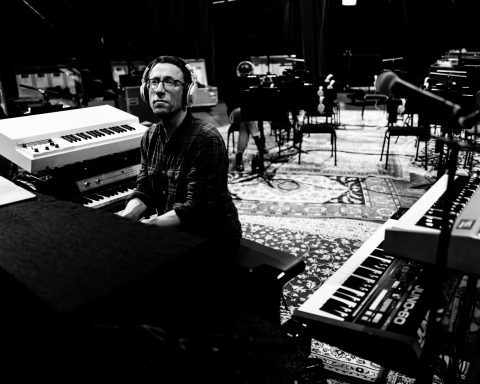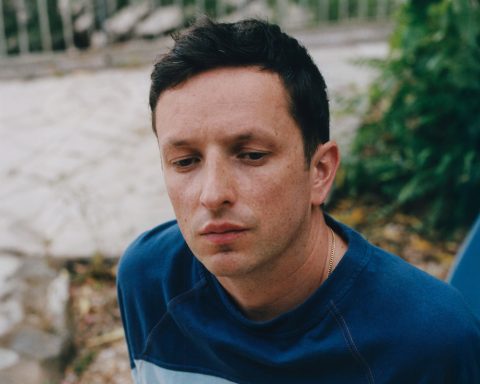Hannah Holland creates moody, enveloping soundscapes as both a club DJ and a film composer. Situated in London after a spell in Berlin, Holland credits the supportive club community with providing the impetus to create visionary sonic statements. Following the release of the soundtrack to Bruce LaBruce’s film The Visitor, Holland examines the path from club kid to DJ to music producer—without ever forgetting the importance of where they came from.
The Scene Provides
Occasionally, the artistic scenes we stumble into during our younger years can shape the whole direction our lives take. Such was the case for Hannah Holland, the prolific UK-based DJ/producer who came up in a storied period in London club culture history.
“I started buying records and DJing in the very early noughties and was going out to a lot of the electroclash scene that was happening in London at that time,” Holland recalls. “That coincided with me buying decks and buying records.”
She cites Peaches as a seminal figure in the era’s zeitgeist which was also gaining footing in Berlin, New York, LA. “That time was pretty wild. It was real mishmash of DIY culture and a meeting of techno and electro and punk.”
Nowadays, Holland is a composer whose work appears on HBO programs and who boasts remix credits for Goldfrapp and The Knife. However, those formative subcultural moments can later lead to professional opportunities, such as the chance to score for cinematic auteur Bruce LaBruce’s latest film, The Visitor. “Being a queer kid in the ’90s, Bruce was this kind of very iconic queer character.”
"That time was pretty wild. It was real mishmash of DIY culture and a meeting of techno and electro and punk.”
A Visitor Arrives
A friend let Holland know the film sought a London-based composer who worked with dance music, and the tendrils of the scene set fate in motion. “We had a meeting, and it was clear it was a good match.” The director described the vision as techno meets Morricone’s original score for Teorema, which The Visitor reimagines. “Then all he said was, ‘It’s going to be wall-to-wall music.’ I was like, ‘OK.’”
Unsettling, foreboding, and yet, at times, oddly life-affirming, the dense compositions draw on the experimental bent of Holland’s records while exploring new avenues linked directly to the film. While rich in complex, step-sequenced syncopation, The Visitor also features hints of traditional instrumentation.
Standout track, “The Screamer,” conveys a sense of pulsating dread emanating from a dirty bass sound, the resulting blend betraying more than a hint of Joy Division in its dirgy brew. “I’ve always played bass since I was a kid in a very kind of punk way—just kind of played in bands,” Holland reveals.
Unreleased Treasures
With so much sonic space to fill on the soundtrack, the director temped the film with cuts from Holland’s own discography. This resulted in the artist unearthing some treasures from the vaults. “A lot of the tracks hadn’t been released and happened to work with what they were after.”
The same sense of fortuity applied to guests on The Vistor, including Ghost Culture, Jonjo Jury, Josh Caffé, Joy Joseph, ROY INC, and Ziah Ziah. All the artists have personal connections to Holland, making their appearances even more satisfying.
“It feels like synchronicity because all those collaborations were tracks I’d made with them or something we’d worked on and hadn’t done anything with yet,” Holland confirms. “But all the collaborators are sort of like from the queer scene. They’re all great friends. So, it just really kind of made a lot of sense, you know?”
"I was doing a lot of fashion music things and being very experimental with that. Club culture is full of designers and filmmakers and there's a real creative scene."
Natural Ascent
Holland’s journey from DJing and experimental artist to in-demand film composer was also natural, and, as with the initial connection, The Visitor, the artist’s vibrant club community played a part in the ascent.
“I was doing a lot of fashion music things and being very experimental with that. Club culture is full of designers and filmmakers, and, you know, there’s a real creative scene.” An early avante-garde adaptation of an Edgar Allan Poe story led to more opportunities. “It came naturally to me to start making these kinds of soundscapes. I did a few short films, then ended up doing a feature film, and went on to do a TV drama. I built up from there.”

The writing and recording processes occur entirely in the artist’s home studio and utilize a curated batch of synths and instruments, including the Roland TR-8S and TB-03. “I absolutely love the TR-8S,” Holland says. “It’s so fun. It just brings up so many ideas and is so creative.”
With a rapidly expanding discography of soundtracks, does Holland see any of these scores making their way into DJ sets? “Not yet. But it’s something that I want to do in the future—to perform my more obscure sort of non-dancefloor stuff.”
"When people ask me what I do, I just say I do music. I make music with synthesizers and DJ house and techno music at clubs and make people dance.”
Striking a Balance
Even with composing work filling out her schedule, the vibe-heavy atmosphere of a club still figures at the center of Holland’s artistic life. “I’m still making club music. I have a residency and tour a lot over the summer,” Holland explains. “So, it’s a balance.”
With a challenging oeuvre incorporating experimental sounds yet brushing up against mainstream media, it’s not easy to categorize Holland’s works. Yet the artist has a straightforward way to describe it: someone detached entirely from the underground electronic scene. “When people ask me what I do, I just say I do music,” Holland laughs. “I make music with synthesizers and DJ house and techno music at clubs and make people dance.”







